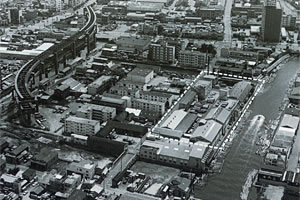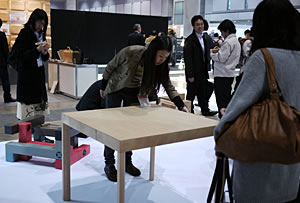History of Tokyo Mokkoujou
1884-1926 (Meiji-Taisho periods)
The history of Tokyo Mokkoujou Arts & Crafts Furnishings goes back some 130 years to 1884. The facility got its start when Shimizu Gumi (now Shimizu Corporation) acquired the former site of the Shogunate’s official lumber purveyor in Fukagawa-Shimadacho (now Kiba, Koto Ward, Tokyo) and began using it as a lumber cutting and assembly facility.
Later, as the Fukagawa Works, the facility was equipped with saws, woodworking equipment, and other machinery to meet growing demand from the construction industry. After the 1923 Great Kanto Earthquake, it served as a depot for lumber materials as part of the recovery efforts in Japan’s capital city.

Tokyo Mokkoujou Arts & Crafts Furnishings during the Taisho Period (1912-1926)
Milestones
- 1884
- Opened at 2 Fukagawa-Shimadacho (now 2-15-3 Kiba, Koto Ward) as a lumber cutting and assembly facility for Shimizu Gumi
- 1896
- Installed steam-powered saw machinery to meet demand for lumber at various construction sites
- 1909
- Installed more saw machinery and joinery machinery; named the Fukagawa Works
- 1923
- Served as a depot for lumber materials transported by horse-drawn wagon and boat as part of recovery efforts after the Great Kanto Earthquake
1926-1989 (Showa Period)
After being completely destroyed in 1945, the facility was quickly rebuilt after the war. It helped procure lumber materials needed for postwar reconstruction, while at the same time expanding its plant facilities. From 1955, it began to acquire various woodworking equipment, including long hot presses and high-frequency equipment. It also acquired facilities to maintain constant temperature and humidity. These and other efforts improved the quality of its wood products and expanded its working capacity.

Tokyo Mokkoujou Arts & Crafts Furnishings (outlined in white dotted line) in 1974. Metropolitan Expressway No. 9, then under construction, is visible to the left.
Plant No. 4 was built in 1962 to meet growing demand for wood construction work, adding five-level hot presses and significantly expanding plant activity. The new plant also marked the start of mass-produced flush doors. The facility was renamed Tokyo Mokkoujou during this year. Organizational reforms designed to further improve quality began in 1979 with the adoption of a total quality control (TQC) system.

The kenjaku (measuring) ceremony in 1970. This ceremony, a simplified version of the ancient tradition of welcoming the New Year by landing a raw log from the river behind the plant and starting up the woodworking machinery to make measuring sticks, has been performed as a Shinto ritual since 1969. The ceremony continues to this day, representing our hopes to pass on traditional woodworking techniques to future generations.
Milestones
- 1945
- Plant facilities expanded as part of efforts to procure materials needed for postwar reconstruction and recovery.
- 1952
- Veneering work begins with the development of new woodworking technology.
- 1955
- New joinery plant opened to improve the quality of joinery work and increase capacity. Production of high-end decorative plywood with veneer sheets also begins with the new hot press.
- 1956
- New high-frequency bonding equipment installed to form wood materials.
- 1962
- New Plant No. 4 built in response to growing demand for lumber work. New five-level hot presses installed in response to rapid growth in plywood work. Mass production of flush doors begins. Renamed Tokyo Mokkoujou.
- 1967
- New Plant No. 3 built. New long hot press equipment demonstrates its capabilities in construction on the Imperial Palace.
- 1969
- Shimizu’s fire-resistant high-end decorative plywood developed with natural veneer sheets and certified by the Minister of Construction.
- 1979
- Total quality control (TQC) system adopted.
- 1983
- Earns certification from the Minister of Economy, Trade and Industry as a plant demonstrating outstanding quality control in the production of factory-produced houses and other products. Shimizu awarded the Deming Prize for implementation of a total quality control (TQC) system.
- 1988
- Awarded outstanding safety award from the Minister of Labor.
1989 through today (Heisei Period)

Tokyo Mokkoujou’s exhibition of the work “Five Tables” wins merit award at IPEC 2010.
Since 1997, to further improve technical skills, Tokyo Mokkoujou staff, chiefly younger employees, have participated actively in outside competitions. Tokyo Mokkoujou’s woodworking technologies have won awards in a wide range of competitions, including the Skills Grand Prix, a national competition among holders of National Trade Skill Testing and Certification first grade certification. (See “Awards” for more information.)
Milestones
- 1992
- Full-scale adoption of CAD system to streamline design operations
- 1994
- Awarded certificate of record length of time without an accident, by industry (3,317,714 hours)
- 1996
- Earned ISO 9001 certification from the Japan Testing Center for Construction Materials
- 1997
- Awarded Minister of Labor Prize in the Skills Grand Prix, furniture-building category
- 2003
- Awarded Minister of Health, Labour and Welfare Prize in the Skills Grand Prix, furniture category
- 2004
- Awarded gold medal in the furniture professions category of the 42nd National Skills Competition
- 2005
- Awarded Minister of Health, Labour and Welfare Prize in the Skills Grand Prix, furniture category
- Competed in the furniture professions category of the WorldSkills Competition
- 2008
- Awarded gold medal in the furniture professions category of the 45th National Skills Competition
- 2009
- Awarded gold medal in the furniture professions category of the 47th National Skills Competition
- 2010
- Awarded gold medal in the furniture professions category of the 48th National Skills Competition
- Wins merit award at Interior Pro Ex Co (IPEC) 2010
- 2011
- Awarded top prize in the 26th Skills Grand Prix, furniture category
- Two employees awarded silver medals in the furniture category of the 49th National Skills Competition
